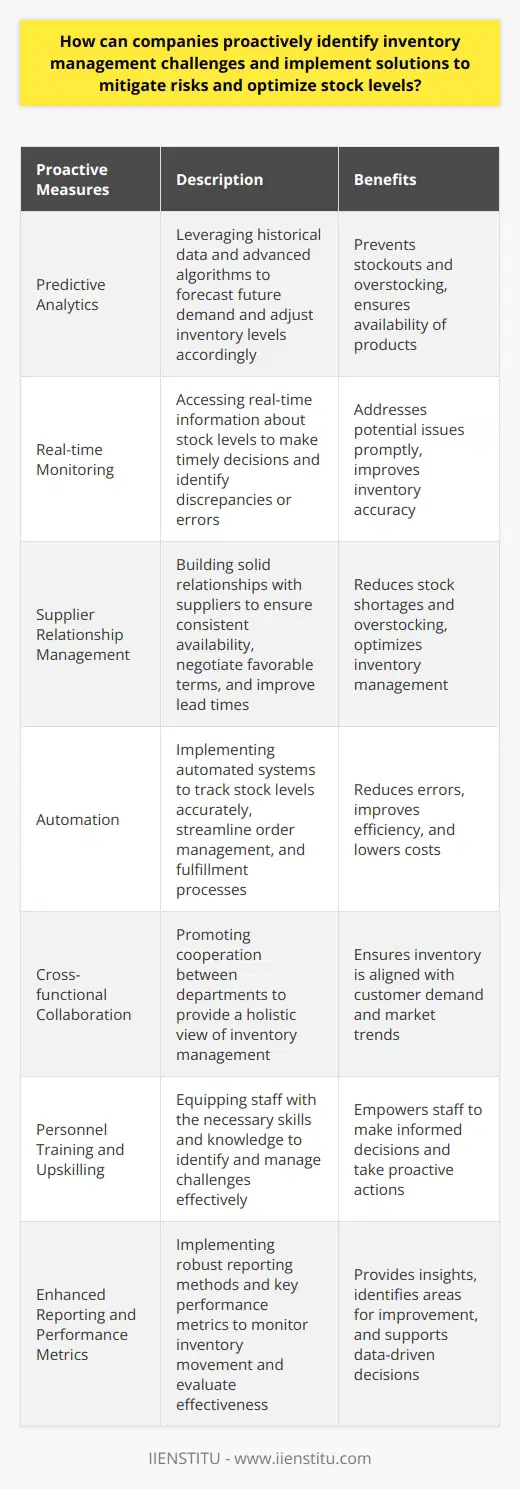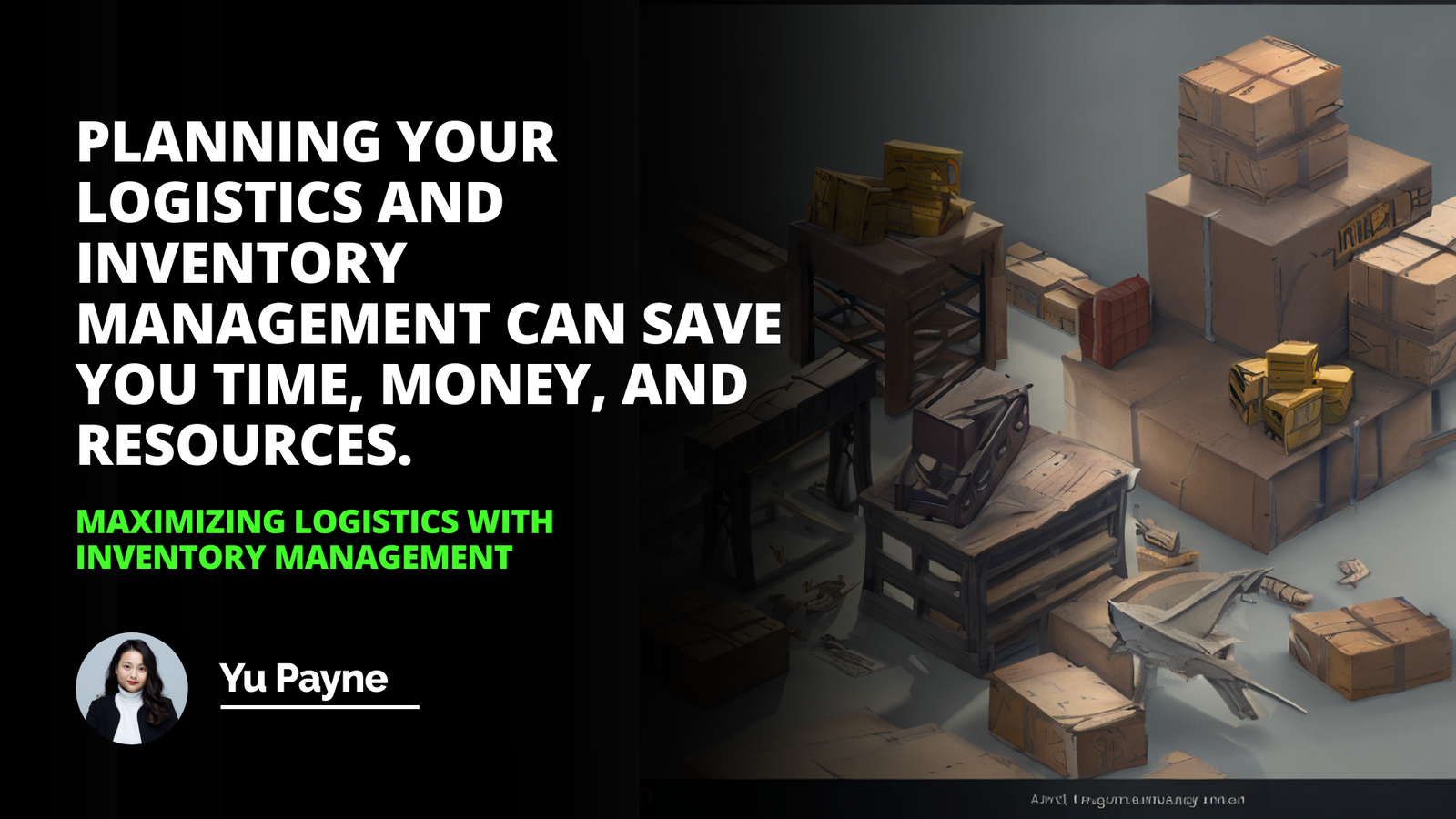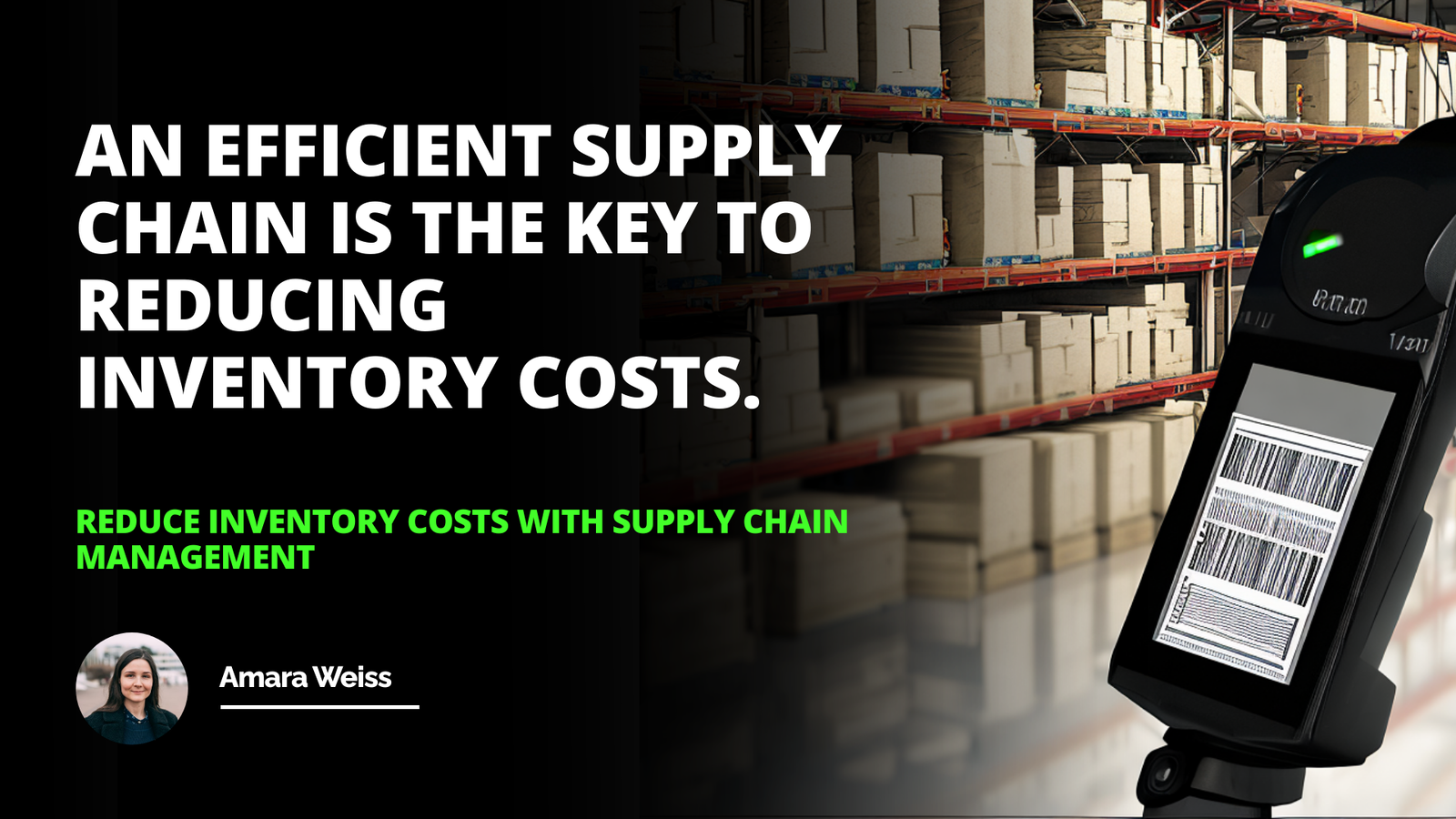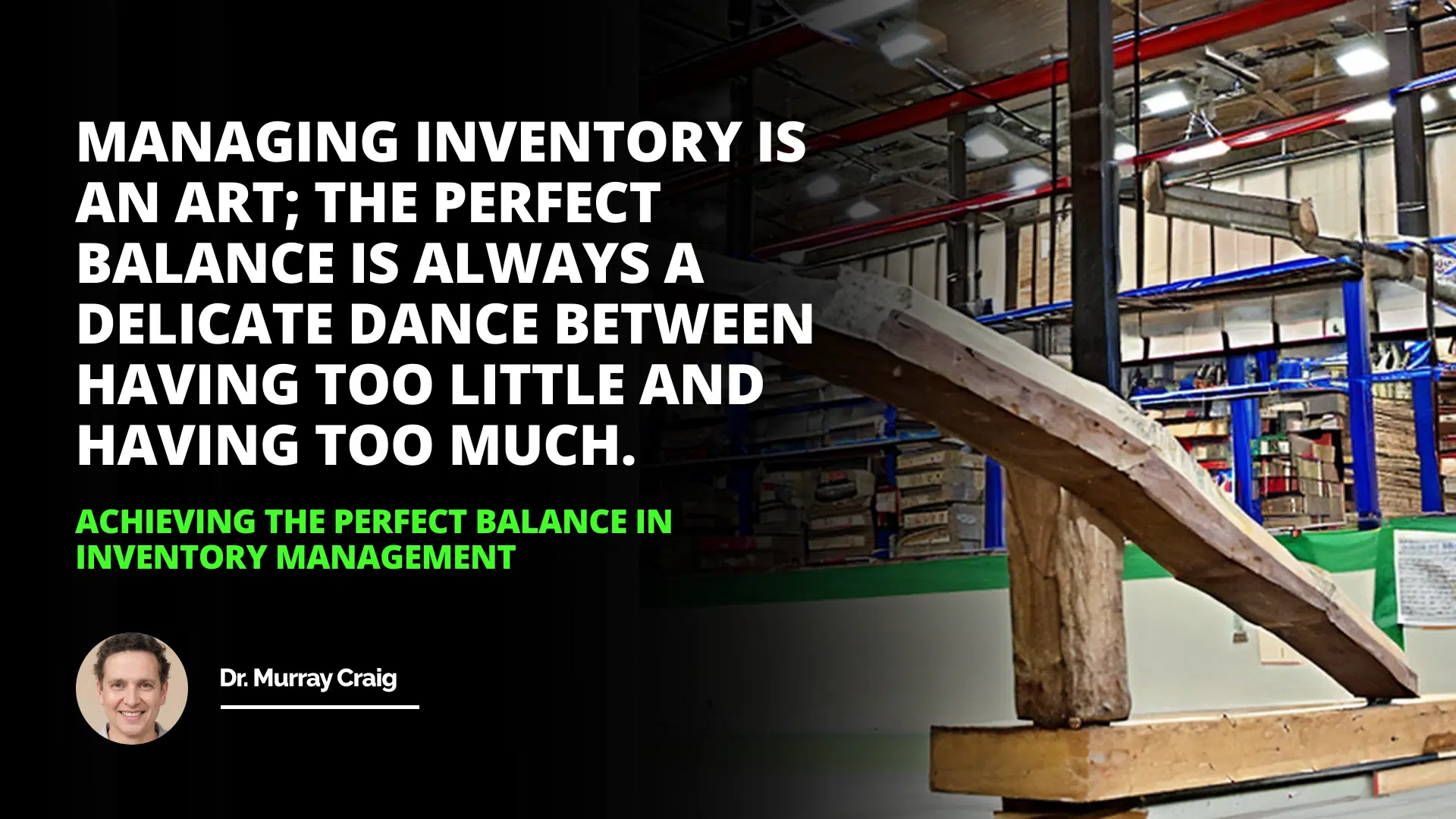
Inventory management refers to tracking and managing a business’s inventory. This includes ordering and tracking goods, materials, and supplies for production and planning, forecasting, and controlling inventory levels.
Achieving the perfect balance in inventory management is essential for success in today’s competitive market. It can result in improved efficiency, cost-effectiveness, and lower risk of stockouts and obsolescence.
Benefits of Achieving Balance when Managing Inventory
The primary benefit of achieving a balance when managing inventory is improved efficiency and cost-effectiveness. By strategically managing inventory levels, businesses can reduce unneeded inventory, which mitigates wasted costs and reduces the need for additional storage space.
Additionally, controlling inventory levels can help to avoid stockouts and obsolescence, which can harm customer satisfaction and result in lost revenues.
The Three Elements that Make Up a Balanced Inventory
Achieving a balanced inventory can be broken down into three distinct elements: calculating stock levels, choosing the right stock, and ongoing evaluations of stock levels. First, businesses must accurately determine the proper inventory levels needed to meet customer demand and have the appropriate supply when it is needed.
This requires effective forecasting, considering seasonal and cyclical demand patterns and customer data. For each item in inventory, businesses should determine the proper size and quantity of stock purchased.
Finally, companies should continually review and adjust their inventory levels to consider current trends, customer demand, and supply availability.
Practical Strategies for Achieving the Perfect Balance
To achieve the perfect balance in inventory management, businesses should implement several practical strategies:
Establishing a reasonable safety stock that includes a buffer for unexpected or unexpected spikes in demand is essential.
Businesses should practice timely data collection and inventory audits, keeping in mind that the accuracy of inventory levels depends on accurate data.
Companies should employ advanced planning and forecasting techniques to control inventory levels better and prepare for unexpected changes in customer demand.
Businesses should also consider investments such as inventory and demand reporting systems to help manage their inventory more effectively.
In today’s increasingly competitive market, achieving the perfect balance in inventory management is essential. Benefits of attaining balance include improved efficiency and cost-effectiveness and lower risk of stockouts and obsolescence. The three elements of a balanced inventory include calculating stock levels, choosing the right stock, and ongoing evaluations of stock levels.
Practical strategies for achieving the perfect balance include establishing a reasonable safety stock, timely data collection and inventory audits, and utilizing advanced planning and forecasting techniques.
In addition, achieving and maintaining balance in inventory management can provide businesses with long-term cost savings and improved customer satisfaction.
Managing inventory is an art. The perfect balance is always a delicate dance between having too little and having too much.
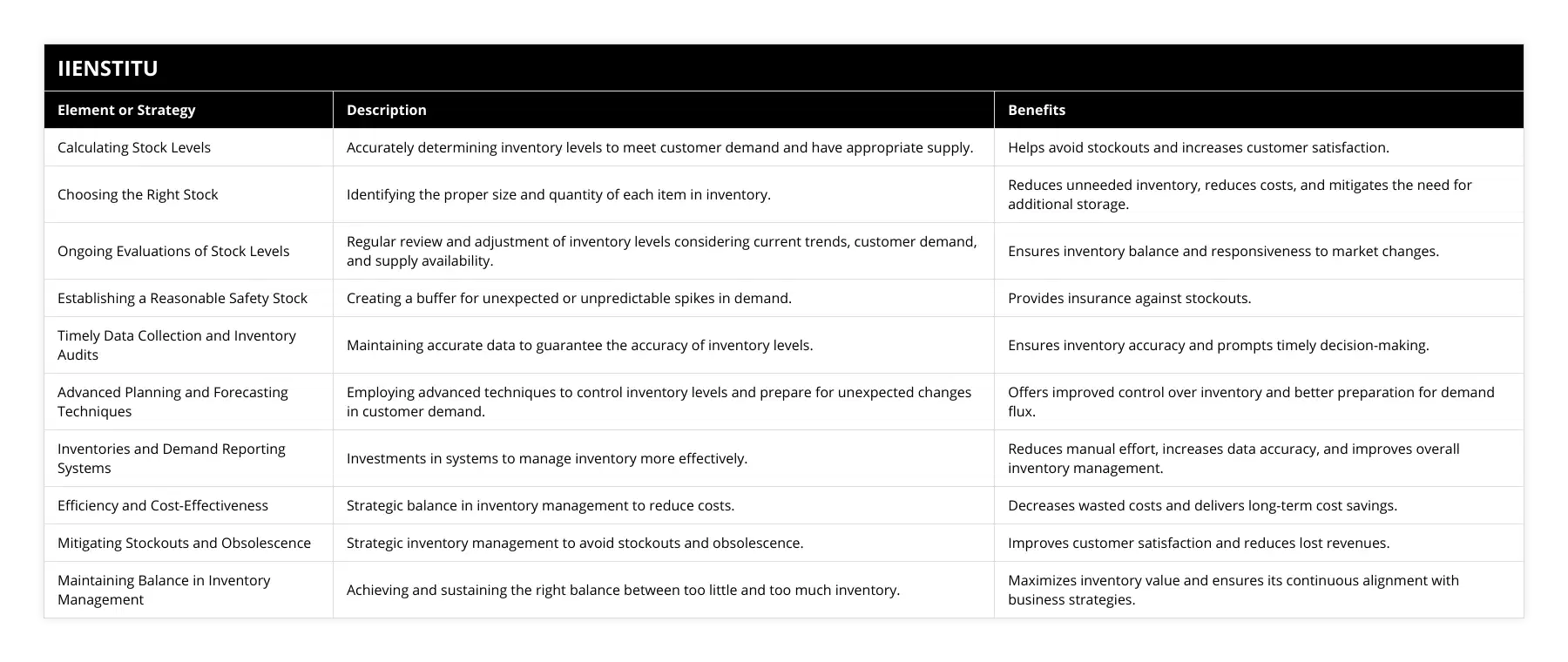
Frequently Asked Questions
What strategies can be used to optimize the inventory management process?
Good inventory management is an essential component of any successful business. When properly implemented, it can help reduce cost and stock levels, increase customer satisfaction, and improve overall efficiency. Optimizing the inventory management process can be achieved through the effective utilization of technology, a proactive approach to managing stock levels, and implementing best practices.
The use of technology can be a crucial component in the optimization of the inventory management process. Barcode scanning, automated stock replenishment, and inventory tracking systems are some strategies that can help businesses keep track of their stock quickly and efficiently. These tools help to reduce manual stock checking, save time and identify and prevent any discrepancies or discrepancies in the data.
A proactive approach to managing stock levels can also help optimize inventory management. For example, establishing a monitoring system and conducting regular reviews can help ensure that stock levels remain appropriate and in line with customer demand. Data analysis can also identify problems and take necessary corrective action.
Finally, the implementation of best practices in inventory management is essential. Establishing accurate stock records, setting appropriate reorder levels, and understanding customer demand are vital strategies for ineffective inventory management. Utilizing supply chain management strategies and improving forecasting accuracy can also help to optimize the inventory management process.
In conclusion, combining technology utilization, proactive stock management, and best practices implementation can help optimize the inventory management process. Taking a strategic approach to inventory management and using the right tools can help businesses have a cost-effective, efficient, and profitable inventory management process.
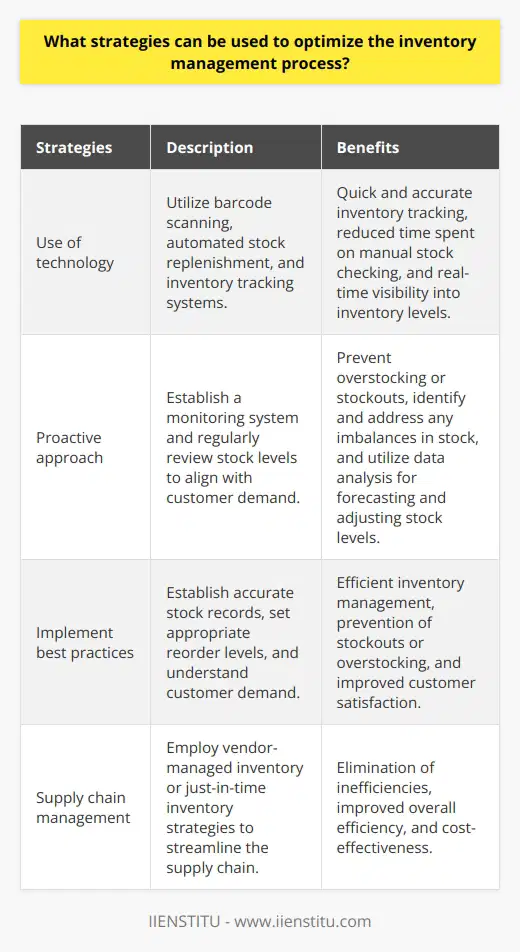
What are the key principles of effective inventory management?
Inventory management is essential to the successful operations of any business. Its role is to coordinate and monitor the flow of goods from production to distribution and ensure that customers receive the product they expect when needed. Therefore, the fundamental principles of effective inventory management must be understood and implemented for businesses to remain competitive and profitable.
The first fundamental principle is accurately forecasting demand. The ability to accurately project customer demand can help businesses optimize their inventory levels and avoid excess inventory that could lead to higher carrying costs and lost sales due to stock-outs. Therefore, companies should collect data from customer trends, buying habits, and market research to forecast demand.
The second principle is leveraging technology. For example, technology can help businesses optimize their inventory management, including tracking inventory levels in real-time and automating tasks such as ordering, tracking, and inventory optimization.
The third principle is utilizing minimum and maximum levels. Setting maximum and minimum inventory levels for each item can help ensure a business has enough stock to fulfill customer orders. However, that supply is manageable.
The fourth principle for effective inventory management is just-in-time ordering. Just-in-time ordering involves ordering only when a customer has placed an order rather than ordering ahead or in bulk. This can help reduce the risk of excess inventory levels and help manage cash flow.
The fifth and final fundamental principle is cycle counting. Cycle counting involves counting a certain number of items in a single cycle. It allows businesses to identify any discrepancies in their inventory more quickly. In addition, allowing firms to track their inventory levels regularly can help reduce the risk of incorrect stock levels.
In conclusion, effective inventory management is essential for businesses to remain competitive and profitable. Companies can create efficient and effective inventory management systems by understanding and implementing the fundamental principles discussed above—such as accurately forecasting demand, leveraging technology, utilizing minimum/maximum levels, using just-in-time ordering, and cycle counting.
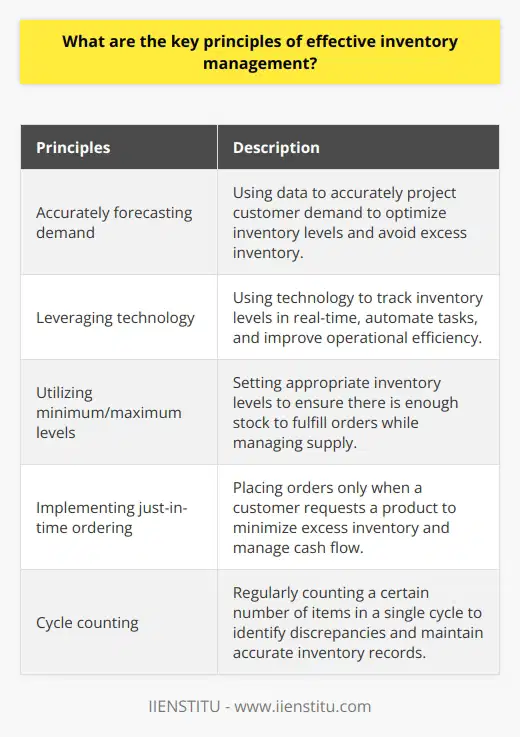
What are the best practices for managing the inventory to ensure a perfect balance between demand and supply?
Effective inventory management ensures the perfect balance between demand and supply in today's changing and increasingly competitive business landscape. Commonly referred to as "Optimal Inventory Management," this process involves accurately tracking the movement of products in and out of your inventory and planning for future needs. While there are no hard and fast rules for achieving the desired results, essential best practices can be implemented to manage inventory more effectively and ensure the balance between supply and demand.
To begin, it is essential to gain a thorough understanding not only of the products that make up your inventory but also of their surrounding market. Comprehending typical consumer consumption habits and the time between purchasing decisions is essential in determining the appropriate amount of inventory that should be kept on hand. Utilizing consumer data analytics can help make informed predictions about current and future demand, which can be applied to creating an appropriate inventory strategy.
Additionally, inventory tracking should be done on a regular basis. By keeping a detailed inventory record of what comes in and out of the facility, any discrepancies can be identified faster and addressed promptly. Similarly, automated inventory tracking systems can be used to account for materials more efficiently. By leveraging advanced features such as automatic reordering, retailers can significantly reduce stock-outs risk and maintain the perfect balance between demand and supply.
Finally, an inventory management system helps optimize the availability of goods and services at a given time. A modern, cloud-based system allows for better coordination between suppliers and demand forecasts, allowing for tailored inventory levels to match fluctuations in sales demand. By integrating all supply chain elements, inventory managers can better manage inventory levels and fine-tune their inventory system to ensure the perfect balance between supply and demand.
In conclusion, while there is no definitive formula to guarantee success in inventory management, the above best practices offer an excellent starting point to help ensure the perfect balance between supply and demand. By leveraging the right technologies, staying informed of the surrounding trends, and creating an efficient inventory tracking system, organizations of all sizes can effectively manage their inventory and maximize their profits.
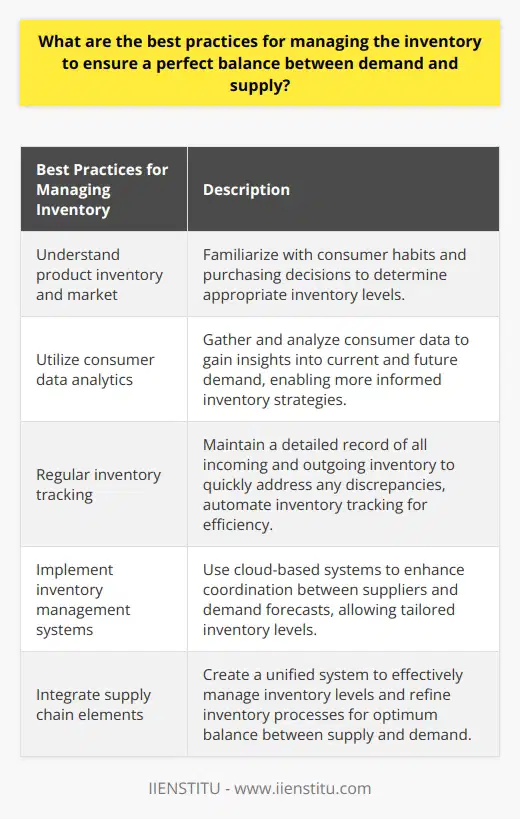
What are the 4 ways of achieving proper inventory control?
**Effective Forecasting Techniques**
Proper inventory control is essential in managing stock levels, preventing shortages, and ensuring customer satisfaction. Achieving proper inventory control involves four key aspects. The first aspect is utilizing effective forecasting techniques. Accurate forecasting provides critical information on the expected demand for products and allows for appropriate inventory planning. Organizations can adopt various techniques such as historical data analysis, market research, and trend analysis to predict demand levels and maintain optimal inventory.
**Real-time Inventory Management Systems**
The second aspect involves employing real-time inventory management systems. These systems provide up-to-date information on stock levels, order processing, and supply chain activities. Real-time monitoring ensures a continuous flow of accurate data that enables organizations to make timely decisions and react swiftly to any inventory-related issues. In addition, adopting digital inventory management tools can help reduce manual errors and improve overall efficiency in managing inventory.
**Establishing Sound Reordering Practices**
The third aspect is the establishment of sound reordering practices. Organizations should have policies in place that regulate when and how much stock to reorder to ensure a consistent supply of products. This involves setting minimum and maximum stock levels, also known as reorder points, and determining the lead time for replenishment from suppliers. Proper reordering practices help prevent stockouts, overstocking, and assure streamlined supply chain management.
**Supplier Relationships and Collaboration**
Lastly, forging strong relationships with suppliers and fostering collaboration forms a crucial aspect of inventory control. Maintaining open lines of communication with suppliers enables organizations to be aware of any potential issues, such as delays or shortages, and respond accordingly. Collaborating with suppliers also allows for better negotiation of favorable terms such as discounts, delivery options, and payment terms, all of which contribute to effective inventory control.
In conclusion, proper inventory control can be achieved through a combination of effective forecasting techniques, real-time inventory management systems, sound reordering practices, and strong supplier relationships. Implementing these strategies can significantly enhance an organization's ability to maintain an optimal inventory level, mitigating risks associated with stockouts or overstocking, and ensuring customer satisfaction.
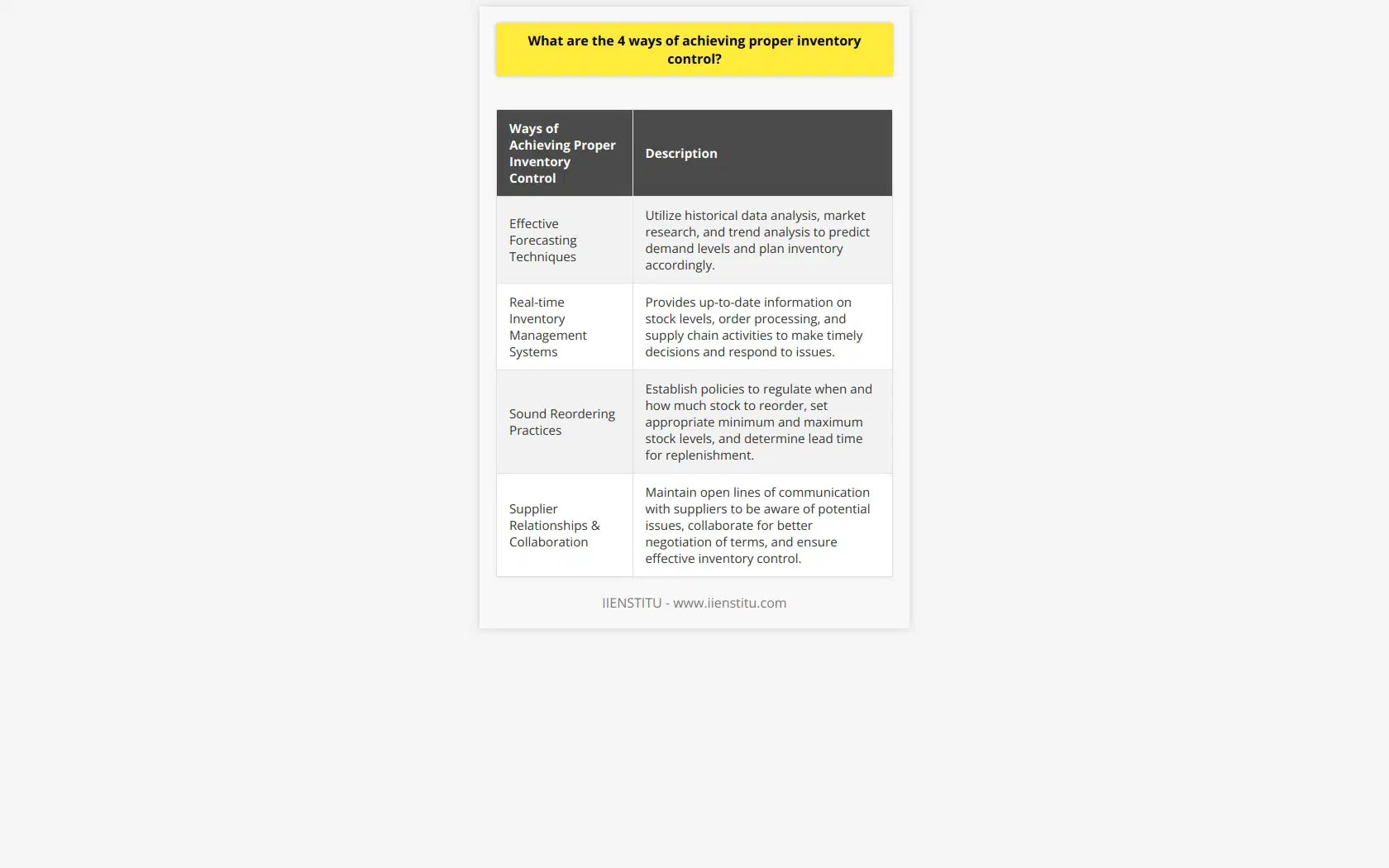
How do you keep your inventory perfect?
Inventory Management Techniques
To maintain an ideal inventory, various inventory management techniques and tools prove effective. A robust inventory management system begins with setting accurate stock levels, regularly updating them, and efficiently organizing the items in storage. Employing these strategies ensures smooth operations and minimizes the risk of stock-related complications.
Establishing Accurate Stock Levels
Assigning precise stock levels involves assessing a product's demand and supply frequency. By analyzing historical sales data and identifying patterns and seasonality, a company can determine optimal inventory levels. Moreover, incorporating safety stock effectively addresses unpredictability in demand or supply chain disruptions.
Conducting Frequent Inventory Audits
Routine inventory audits help identify discrepancies between the physical stock and the documented figures. These audits can be conducted through annual or cyclical counts, relying on random sampling of items. Spot checking of high-value and fast-moving inventory items further enables timely detection and resolution of issues.
Implementing FIFO (First-In, First-Out)
The FIFO method ensures the oldest items in the inventory move out first, reducing the chances of obsolete or expired products. FIFO assists in maintaining product quality and mitigates the risk of financial losses associated with spoiled or outdated inventory. An organized warehouse facilitates FIFO by placing new items behind existing stock, ensuring efficient stock rotation.
Automating Inventory Management
Inventory management software can optimally track and update inventory levels, generate accurate demand forecasts, and produce real-time reports. Automation reduces the likelihood of human error and frees up time for managers to focus on strategic decision-making. Implementing barcoding systems and integrating them with management software enables seamless inventory tracking and monitoring.
Prioritizing Inventory with ABC Analysis
An ABC analysis groups inventory items into three categories, with 'A' items being the most valuable and requiring closer monitoring. By prioritizing these high-value items, businesses can optimize inventory control efforts and resources. Consequently, this approach minimizes stock-outs, overstocking, and loss of critical inventory items.
In conclusion, achieving an ideal inventory necessitates meticulous management, including setting accurate stock levels, auditing regularly, implementing FIFO, automating processes, and prioritizing inventory using ABC analysis. Each of these methods contributes to smooth operations, loss prevention, and sustained product quality. By diligently utilizing these techniques, a company can maintain a perfect inventory and focus on achieving its growth objectives.
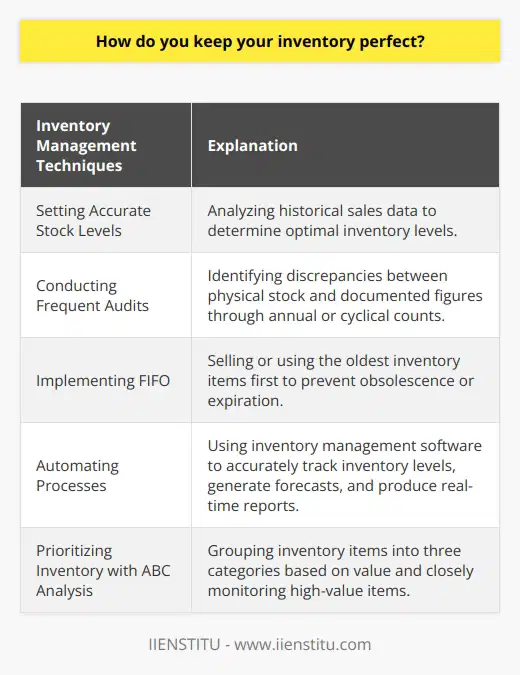
What does maintaining the optimum balance of inventory mean to ensure?
Optimum Inventory Balance Significance
Maintaining the optimum balance of inventory refers to keeping an ideal amount of stock on hand to ensure that a business can efficiently meet customer demands without incurring undesirable costs. This balance is critical for several reasons.
Customer Satisfaction
Firstly, having the right inventory levels guarantees that customer demands are met promptly. Delays in order fulfilment due to stockouts can negatively impact customer satisfaction and lead to customers seeking alternative suppliers. Thus, maintaining the optimum inventory balance is essential in retaining and attracting clientele.
Cost Management
Secondly, cost management is a core aspect of inventory management. Holding excess inventory ties up financial resources in the form of working capital and incurs additional storage and handling costs. Conversely, carrying insufficient inventory can lead to missed sales opportunities and increased costs due to expedited shipments. Striking an ideal balance between overstocking and understocking helps businesses minimize these costs.
Supply Chain Efficiency
Thirdly, achieving an optimum inventory balance directly influences supply chain efficiency. By adeptly matching inventory levels to demand fluctuations, businesses can create a more stable and predictable environment for their supply chain partners. This fosters better relationships with suppliers and logistics providers, resulting in a more effective and coordinated supply chain operation.
Competitive Edge
Lastly, a well-balanced inventory directly translates to a competitive advantage in the marketplace. With the ability to meet customer demands promptly and the avoidance of excess costs, businesses can pursue growth opportunities, improve profit margins, and ultimately stay ahead of the competition.
In conclusion, maintaining the optimum inventory balance is crucial for business performance. It ensures customer satisfaction, enables effective cost management, improves supply chain efficiency, and offers a competitive edge. Businesses must therefore invest time and resources in tools and strategies to achieve this critical balance.
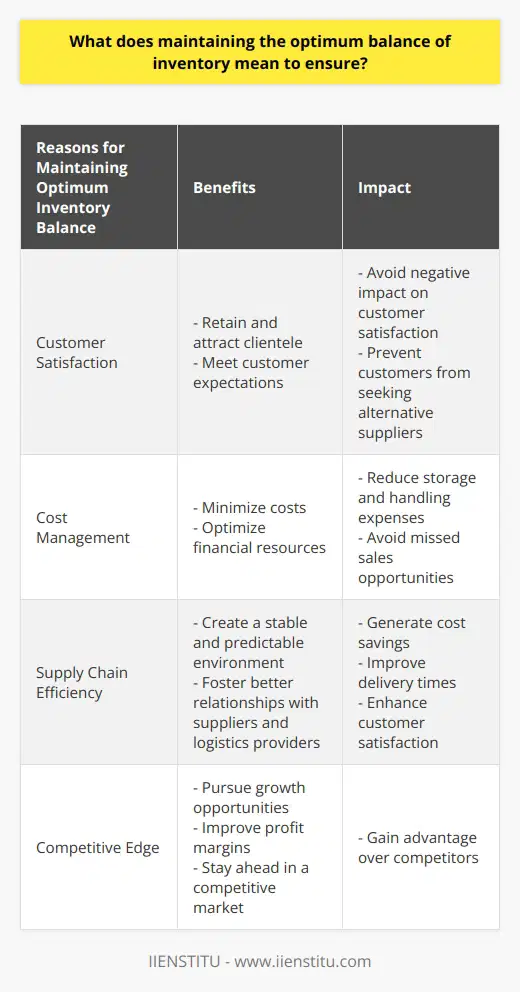
What are the 3 major inventory management techniques?
Major Inventory Management Techniques
Managing inventory is essential for businesses to ensure that stocks are maintained at optimal levels, balancing customer demand and minimizing stock-related costs. Three major inventory management techniques are: Just-In-Time (JIT), Economic Order Quantity (EOQ), and ABC Analysis.
Just-In-Time Method
The Just-In-Time (JIT) method aims to minimize the inventory levels by aligning the production process with customer demand. It involves ordering materials and producing goods only as needed, reducing storage and holding costs. JIT requires continuous monitoring of demand, supplier lead times, and production processes to ensure that inventory levels are always adequate to meet customer needs without overstocking.
Economic Order Quantity Model
The Economic Order Quantity (EOQ) model helps businesses determine the optimal order size to minimize total inventory costs, including ordering, holding, and shortage costs. By calculating EOQ, businesses can decide when to place an order and how much to order, ensuring that inventory is replenished just as it is needed. This technique requires accurate demand forecasting and constant reevaluation of the EOQ formula, taking into account changes in demand, ordering costs, and holding costs.
ABC Analysis Technique
Lastly, the ABC Analysis technique classifies inventory items based on their value and importance to the business. Items are categorized into three groups: A, B, and C. Category A items are high-value and high-priority, requiring close monitoring and rigorous control. Category B items have medium value and priority, while Category C items have the lowest value and priority. By focusing on the more valuable items, businesses can optimize their inventory management efforts and allocate resources more efficiently.
In conclusion, JIT, EOQ, and ABC Analysis are the major inventory management techniques that help businesses optimize their inventory control. By implementing one or a combination of these methods, businesses can achieve better cost management, higher customer satisfaction, and improved operational efficiency.
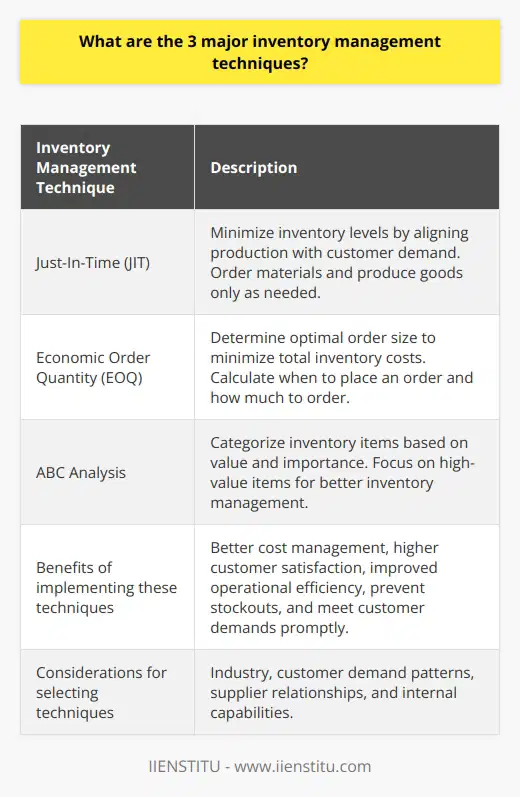
How can an organization maintain the optimum balance of inventory to ensure customer satisfaction and cost-effectiveness?
Understanding Inventory Balance
An organization can maintain the optimum balance of inventory to ensure customer satisfaction and cost-effectiveness by implementing a comprehensive inventory management system. This system would ideally involve accurate demand forecasting, timely reordering, and efficient warehouse management practices.
Accurate Demand Forecasting
A critical aspect of maintaining the right inventory balance is accurately predicting customer demand. Organizations can use historical sales data, market analysis, and seasonal trends to develop a reliable forecasting model. By understanding customer behavior and preferences, organizations can make informed decisions about the amount and type of products to stock. This prevents stockouts, maintains adequate inventory levels, and meets customer expectations.
Timely Reordering
Proactive reordering is essential to ensure that stock levels remain at the desired levels. Organizations can utilize an economic order quantity (EOQ) model to determine the most cost-effective order quantities and reorder points. By monitoring inventory levels and placing timely orders, the organization can avoid excessive lead times that might lead to customer dissatisfaction. Moreover, careful planning minimizes the risk of having dead stock that results in wasted resources or obsolete products.
Efficient Warehouse Management
Adopting an efficient warehouse management system (WMS) enables organizations to optimize their inventory control processes. A proper WMS can help organizations maintain real-time inventory updates, facilitating visibility and control of the stock levels. Warehouse management practices such as regular cycle counting and space optimization can contribute to reducing storage costs and improving overall operational efficiency.
Leveraging Technology
Technology, including inventory management software and automation tools, can offer valuable support in maintaining the inventory balance. In addition to tracking and managing inventory levels more efficiently, these solutions can also provide insights and analytics to aid in better decision-making. As organizations continue to evolve and grow, the integration of technology will remain a key factor in enhancing inventory management capabilities, ensuring customer satisfaction and cost-effectiveness.
In conclusion, maintaining the optimum balance of inventory is a delicate challenge – one that requires an understanding of customer demand, strategic planning, and the effective utilization of technology. By incorporating these elements, organizations can ensure that they are equipped to meet customer expectations while simultaneously minimizing costs and maximizing efficiency.
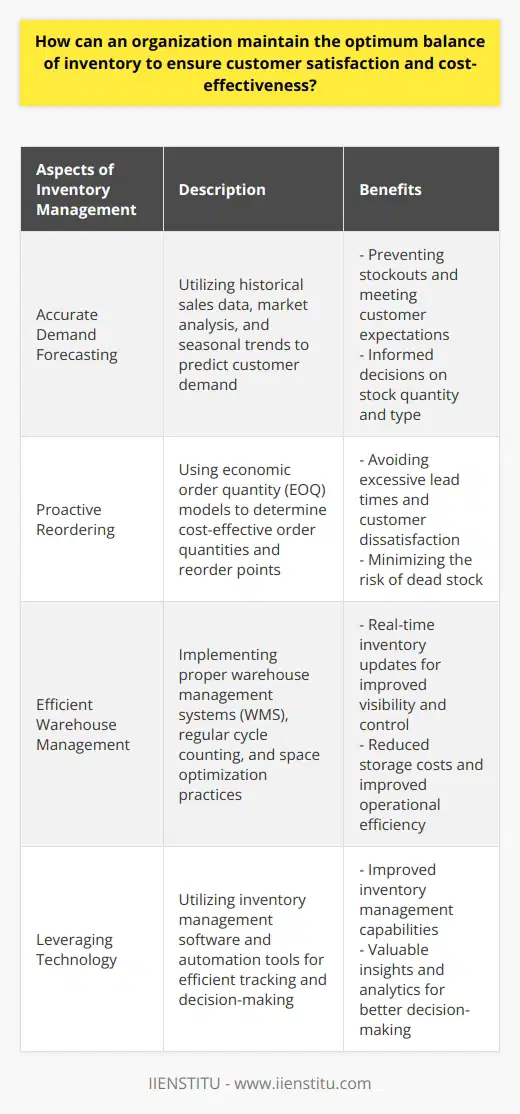
What key factors should be considered when developing an effective inventory control system?
Understanding Customer Demand
One crucial factor that must be considered when developing an effective inventory control system is understanding customer demand. Analyzing historical sales data and seasonal fluctuations can help forecast future demand accurately. This information, in turn, supports better management of inventory levels, maintaining a balance between overstock and stock-out situations.
Supplier Relationships and Lead Times
Building strong supplier relationships and identifying reliable lead times are essential elements in inventory control systems. By establishing clear communication with suppliers, businesses can obtain the necessary information to make informed decisions about inventory stocking schedules. Tracking supplier performance regarding delivery and product quality helps to evaluate and select the most suitable partners to facilitate seamless stock replenishment.
Inventory Turnover Ratio
The inventory turnover ratio, an essential metric needed for effective inventory control, represents the number of times a company sells and replaces its inventory within a given period. Higher inventory turnover ratios indicate better performance in managing stock levels, leading to reduced holding costs and obsolescence. An effective inventory system should monitor this metric and provide actionable insights to improve overall inventory management.
Safety Stock and Reorder Points
Safety stock and reorder points play a significant role in minimizing the risk of stock-outs and lost sales. Ensuring an optimal level of safety stock protects businesses from unexpected demand surges or supply delays. Implementing strategic reorder points helps maintain adequate inventory levels while avoiding excessive stock holding. An efficient inventory control system must have mechanisms in place to determine these critical levels and notify inventory managers for timely action.
Warehouse Management
Effective warehouse management, including optimizing storage layout and implementing accurate tracking systems, is a vital factor in inventory control. Efficient stock organization leads to reduced retrieval times, increased accuracy in order picking, and better overall inventory management. Utilizing technology such as barcoding and warehouse management software can greatly enhance warehouse operations and contribute to the success of inventory control systems.
Regular Auditing and Cycle Counting
Continuous improvement of inventory control systems requires regular auditing and cycle counting. These practices ensure increased data accuracy, early detection of discrepancies, and prompt resolution of identified issues. By conducting frequent audits and cycle counts, businesses can maintain stock accuracy and improve overall inventory control.
In conclusion, developing an effective inventory control system necessitates consideration of several key factors, including understanding customer demand, fostering solid supplier relationships, adopting relevant performance metrics, maintaining appropriate safety stock and reorder points, optimizing warehouse management, and implementing regular auditing processes. Combined, these elements contribute to a robust inventory control system that maximizes efficiency, minimizes losses, and enhances business performance.
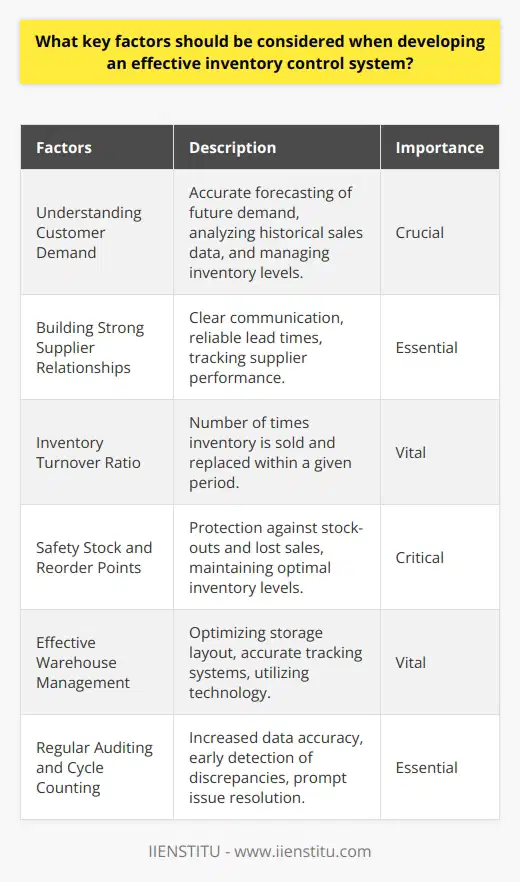
What is the ideal rule in managing inventory?
Ideal Rule: Economic Order Quantity
The ideal rule in managing inventory is Economic Order Quantity (EOQ), a widely embraced approach in inventory management. This rule maintains a balance between order costs and holding costs while ensuring demand is met efficiently. The EOQ formula, which calculates the optimal order quantity, is centered on cost minimization.
Benefits of EOQ
The primary advantage of EOQ is cost reduction. By determining the ideal order quantity, businesses can minimize costs associated with excessive inventory holding, wasted storage space, and stockouts. Furthermore, EOQ helps organizations establish a systematic replenishment process, streamlining supply chain operations. This optimization allows companies to allocate resources more effectively.
Demand Predictability and EOQ
Accurate demand forecasting plays a pivotal role in the success of the EOQ system. Organizations must have a clear understanding of their customers' requirements to maintain the appropriate inventory levels. Demand fluctuations and seasonality factors should be taken into account when applying EOQ to maximize its benefits.
Batch Ordering Strategy
EOQ complements the batch ordering strategy, allowing businesses to purchase the optimal quantity of inventory while minimizing costs. This is particularly beneficial for industries where bulk discounts are common or perishable items are involved, as it enables decision-makers to order the right amount of stock at the most cost-effective intervals.
Adjustment for Real-World Factors
While EOQ is a powerful inventory management rule, it also necessitates customization to accommodate real-world factors, such as supplier lead time and perishability. Customizing the EOQ rule to account for these factors improves the approach's effectiveness and ensures accurate cost minimization.
In conclusion, the ideal rule in managing inventory is the Economic Order Quantity (EOQ) system. By focusing on cost minimization and incorporating accurate demand forecasting, batch ordering, and adjustments for real-world factors, EOQ can significantly improve supply chain efficiency and resource allocation.
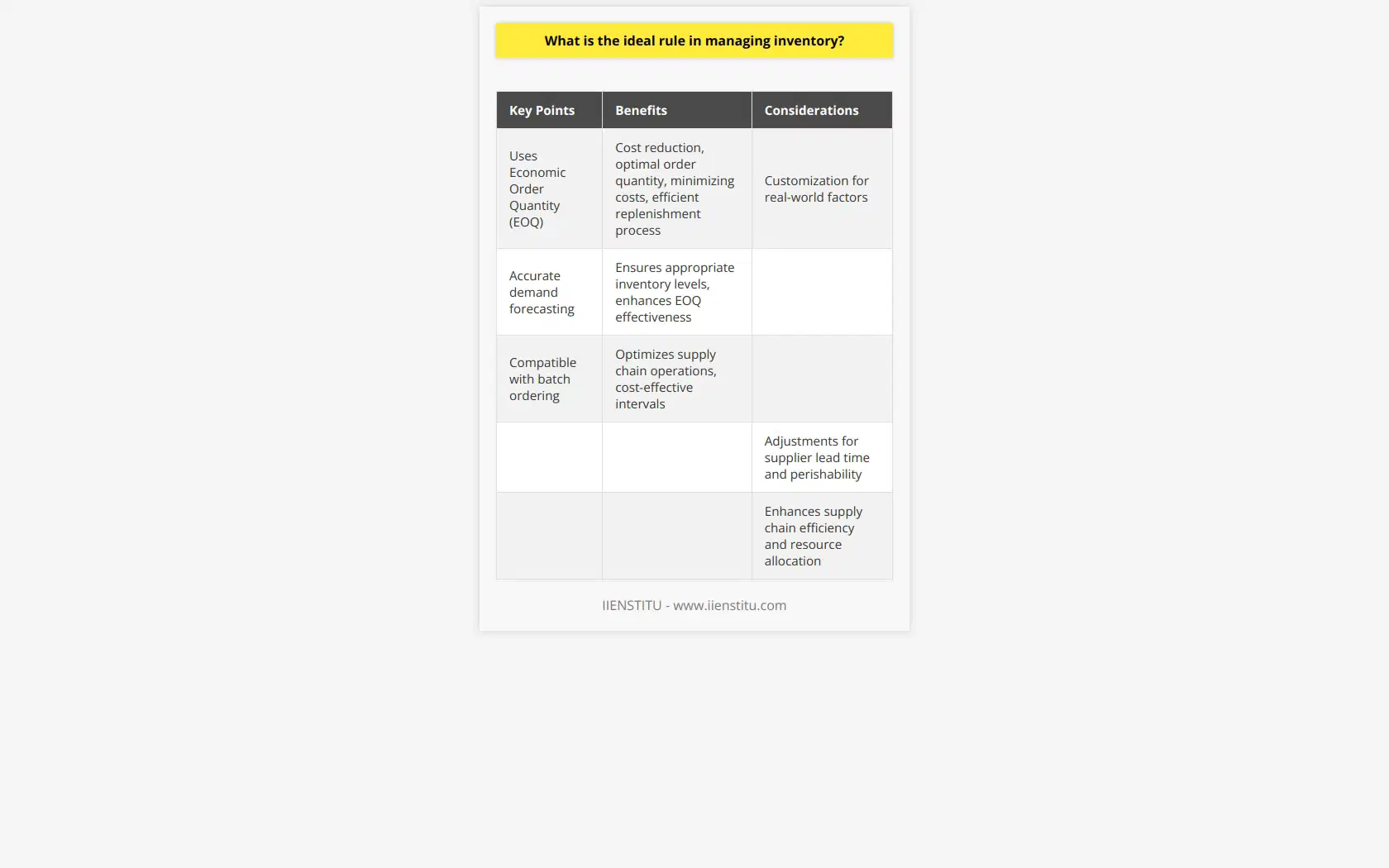
How can organizations effectively balance the costs and benefits of inventory management?
Balancing Costs and Benefits in Inventory Management
Effective Inventory Control Techniques
Organizations can effectively balance the costs and benefits of inventory management by employing various control techniques. These may include adjusting inventory levels according to demand forecasts, implementing just-in-time inventory systems, and utilizing inventory management software. By adopting these techniques, organizations can optimize the trade-off between holding costs, stockouts, and capital tied up in inventory.
Demand Forecasting and Reordering Points
Effective demand forecasting significantly contributes to balance inventory management costs and benefits. By accurately predicting product demand, organizations can determine the optimal time and quantity to reorder, thereby reducing holding costs and the likelihood of stockouts. Regularly reviewing and adjusting the reordering points based on inventory turnover can also contribute to an efficient inventory management system.
Just-in-Time Inventory Systems
Implementing just-in-time (JIT) inventory systems can assist organizations in maintaining a delicate balance between costs and benefits. JIT systems focus on maintaining minimum inventory levels and receiving shipments only when needed, thus reducing capital tied up in inventory and lowering holding costs. However, careful planning and coordination with suppliers are essential for the success of JIT strategies to prevent potential stockouts and disruption in the supply chain.
Inventory Management Software
Utilizing inventory management software can streamline the inventory management process, enabling organizations to monitor inventory levels in real-time, automate reordering processes, and manage multiple warehouses. By harnessing the power of digitalized inventory management systems, organizations can increase order accuracy, improve warehouse efficiency, and reduce instances of stockouts and overstocking.
Balancing Inventory Costs with Customer Satisfaction
Organizations should consider customer satisfaction as a critical factor in achieving the optimal balance between the costs and benefits of inventory management. To ensure customer satisfaction and retain a competitive edge, organizations must refine their inventory management strategies to reduce lead times, calculate safety stock levels accurately, and ensure the availability of products as needed.
In conclusion, organizations can effectively balance the costs and benefits of inventory management by employing various inventory control techniques, such as demand forecasting, JIT systems, and inventory management software. These strategies can help optimize inventory levels, minimize holding costs, and ensure customer satisfaction, ultimately contributing to a more efficient and profitable organization.

What approaches can be utilized to minimize inventory holding costs while ensuring sufficient stock availability?
Assessing Demand Forecast
To minimize inventory holding costs while ensuring sufficient stock availability, one should start by accurately assessing the demand forecast. This will help determine the appropriate inventory level and avoid overstocking, contributing to reduced costs. Utilize historical data, market trends, and analysis of customer demand patterns to optimize stock replenishment.
Implementing Just-In-Time (JIT) System
Another approach to reducing inventory holding costs is the adoption of the Just-In-Time (JIT) system. JIT focuses on acquiring and producing materials only when required, thus minimizing stock levels. The implementation of JIT systems not only saves costs but also encourages efficient production processes and effective supplier relationships.
Optimizing Warehouse Space
Efficient utilization of warehouse space also plays a crucial role in reducing inventory holding costs. By optimizing storage layouts, one can minimize labor requirements and handling costs, ultimately leading to cost reductions. Regularly review the stock organization and consider leasing temporary storage spaces during high demand seasons to avoid excessive stock holding.
Applying Vendor-Managed Inventory (VMI)
Collaborative inventory management, specifically Vendor-Managed Inventory (VMI), enables suppliers to monitor and replenish stock levels as needed. This approach shifts inventory management responsibility to the supplier and can significantly lower holding costs. Additionally, VMI improves stock availability and strengthens the relationship between suppliers and businesses.
Enhancing Inventory Management Technology
Investing in advanced inventory management technology can improve stock accuracy, visibility, and efficiency. Implementing tools such as barcoding, radio-frequency identification (RFID), and Warehouse Management Systems (WMS) can automate essential inventory processes, minimize human error, and reduce holding costs. Technology can also facilitate real-time monitoring and data analysis for better decision-making.
In conclusion, minimizing inventory holding costs without compromising stock availability requires a combination of accurate demand forecasting, efficient inventory management techniques such as JIT and VMI, optimal warehouse space utilization, and the implementation of advanced inventory management technology. These strategies can work synergistically to reduce costs while maintaining sufficient stock levels and meeting customer needs.
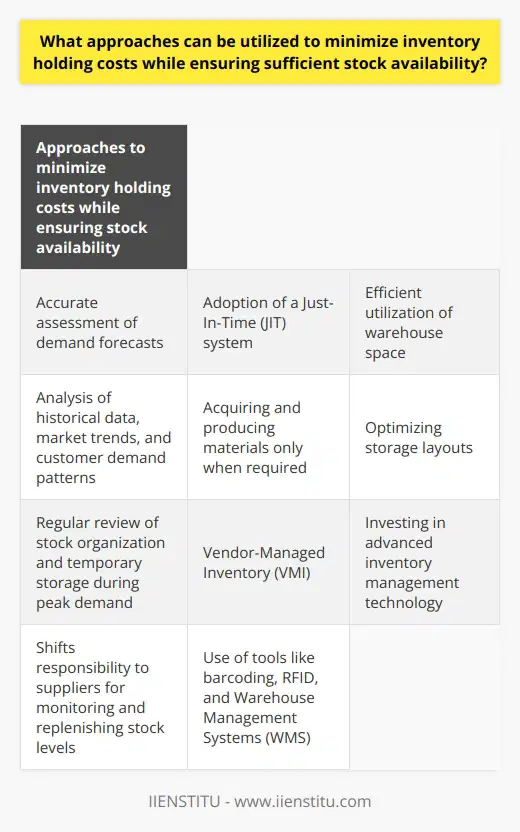
What are the key components of a successful inventory control system, and how do they contribute to maintaining stock levels?
Efficient Data Management
One of the essential components of an effective inventory control system is efficient data management. Effective data management ensures accurate recording, tracking, and analyzing of stock levels. A robust database, equipped with automation features, minimizes manual input errors and ensures precision.
Frequent Stock Auditing
Regular stock auditing is another crucial part of inventory control. It involves routine checks of physical stocks against recorded figures. It is with this method that discrepancies get identified and corrected. The frequency of this process contributes to maintaining accurate stock levels.
Forecasting and Analyzing Demand
Understanding market demand forms an integral part of successful inventory control. Forecasting and analyzing customer demand allows for optimal inventory stocking. The consumption patterns keep changing according to various factors like seasonal demand, overall economic climate, and customer preferences. Regular analysis and adaptation to these trends prevent both overstocking and stock-outs.
Synchronized Supply Chain
Integrating and synchronizing the supply chain is a critical aspect of inventory control. It ensures the flow of information from suppliers to customers is seamless and efficient. A synchronized supply chain minimizes delays in replenishing stock, reducing the risk of stock-outs or excess stock.
Strategic Vendor Management
Developing good relationships with vendors is another key element of successful inventory control. Strategic vendor management leads to timely delivery of stocks, adherence to quality specifications, and transparent conversation in case of any discrepancies or shortfall. A reliable vendor contributes to maintaining consistent stock levels, thus preventing any disruptions in the business.
Using these key components, a successful inventory control system ensures that businesses maintain optimal stock levels. It not only prevents the financial losses associated with stock-outs and overstocking but also contributes to customer satisfaction by ensuring timely provision of goods.
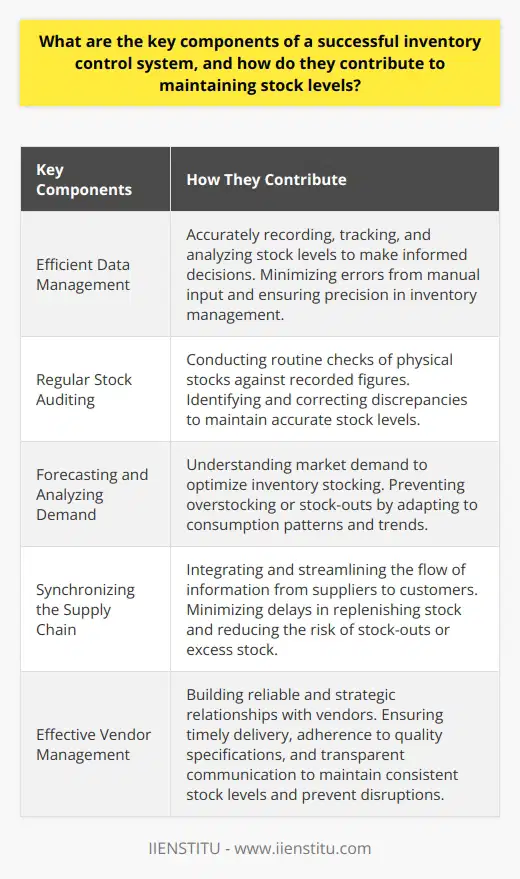
What role does forecasting play in inventory management, and how can organizations improve their demand predictions for more accurate stock control?
Role of Forecasting
In inventory management, forecasting plays a pivotal role. It allows organizations to estimate the number of products they need to have in stock. This prediction assists in minimizing incidences of overstock or stockouts, ensuring customer satisfaction.
Improving Demand Predictions
A more accurate demand forecast can maximize profitability by optimizing stock control. Regular data analysis is crucial in this process. Organizations can evaluate past sales figures, consider industry trends and potential market changes to modify their future stock levels.
Techniques for Accurate Forecasting
Various methods can help in enhancing demand forecasting accuracy. Techniques such as moving averages, exponential smoothing, and regression analysis can be instrumental when incorporated.
Integration of Technology
Moreover, the integration of technological tools like Enterprise Resource Planning (ERP) software can automate the forecasting process. This leads to quicker, more efficient predictions by eliminating manual error.
Feedback and System Updates
Regular feedback from different department heads can provide insights into demand patterns. Additionally, doing constant system updates and adjustments based on the latest sales data also aids accuracy.
Training and Skill Development
Training staff for effective demand forecasting should be seen as an investment. An understanding of forecasting techniques ensures more accurate predictions.
In conclusion, forecasting is integral to inventory management. It not only optimizes stock control but also maximizes profitability. Continuous effort in improving forecasting techniques, integrating technology and training can contribute to accurate demand predictions.

How can companies identify potential inventory management challenges and implement proactive solutions to mitigate risks and optimize their stock?
Analyzing Inventory Trends
Companies can identify potential inventory management challenges by analyzing the inventory trends. This involves examining historical data, scrutinizing sales patterns, and assessing product life cycles.
In-depth Data Analysis
In-depth analysis can reveal fluctuations in demand, helping companies predict future inventory requirements. They can spot occasional sales spikes or dips, identify slow-moving items, and recognize seasonal sales patterns.
Implementing Demand Forecasting
Implementation of demand forecasting tools can propel companies to predict future sales more accurately. It's crucial in managing reordering times and quantities, reducing out-of-stock situations, and lowering excess inventory.
Consideration of Lead Time
A thorough understanding of lead times is also significant. Knowing the time required to reorder and receive items minimalizes stock-outs and excess inventory.
Adoption of Just-In-Time Technique
Adopting the Just-In-Time (JIT) inventory technique can also help mitigate risks. JIT involves ordering only what is necessary for production at the right time, reducing stock holding costs.
Utilization of Inventory Management Tools
Companies can leverage inventory management tools to optimize stock. These tools offer real-time inventory tracking, alerts for low-stock items, and insightful reports that aid in smart decision-making.
Strengthening Supplier Relationships
Strengthening relationships with suppliers can help avoid supply disruptions. Having reliable suppliers assures timely delivery, which is crucial for optimal inventory management.
Continuous Training
Lastly, continuous training and education for employees responsible for managing inventory ensures they understand and can adapt to new inventory management techniques or tools. This readiness to learn and adapt ultimately contributes to a more efficient inventory system.
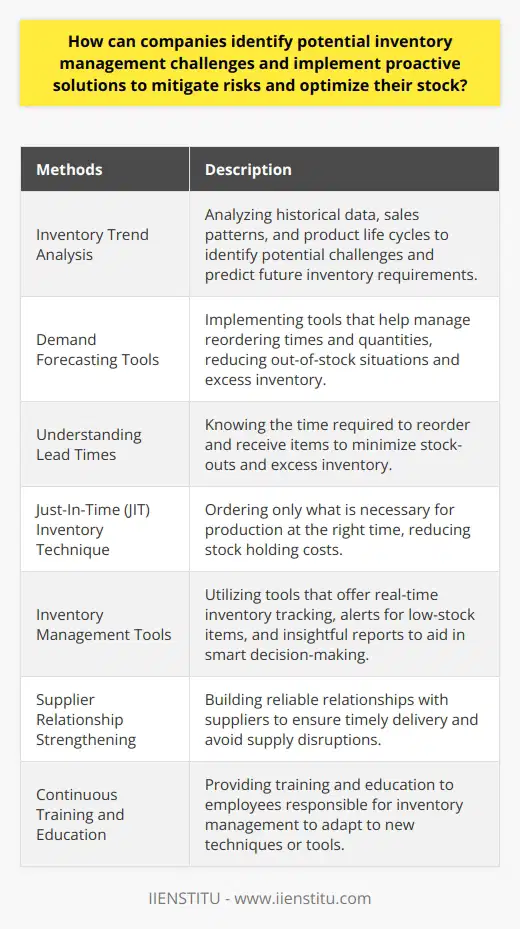
What are the critical factors to consider when implementing inventory management techniques to maintain the optimum balance of stock?
Critical Factors: Demand Forecasting and Safety Stock Levels
The first critical factor in implementing inventory management techniques is accurate demand forecasting. Understanding customer demand helps businesses maintain a balance between stock shortage and excess. Reliable and updated data for demand forecasting is crucial.
Optimal Safety Stock Levels
Safety stock provides a cushion against unexpected demand or supply chain disruptions. Determining correct safety stock levels requires an understanding of demand variation and lead time. The goal is to limit stockouts without causing overstocking.
Lead Time Considerations
Another important aspect remains the awareness and management of lead times. Any delay in replenishment can lead to stockouts, negatively impacting customer satisfaction. Effective monitoring and communication with suppliers ensure timely stock replenishment.
Supplier Relationships
Maintaining healthy supplier relationships influences the efficacy of inventory management. It ensures reliable stock supply and offers room for negotiation in pricing and delivery schedule, subsequently enhancing stock balance.
Consideration of Product Life Cycle
Consideration of a product's life cycle helps in efficiently managing stock levels. High demand during the growth or maturity stage necessitates larger inventory levels. Conversely, during the decline phase, businesses should avoid overstocking.
Inventory Review
Periodic inventory review helps avoid surplus or deficit situations. ABC analysis or other inventory review methods can highlight the products requiring maximum attention. Regular reviews can streamline stock levels, reducing carrying costs and potential stock obsolescence.
Technology Utilization
Incorporating technology in inventory management enhances accuracy and efficiency. An inventory management system automates processes, reduces human error, and allows real-time tracking. This leads to optimum stock balance and improved decision-making.
Overall, successful implementation of inventory management techniques depends on a thorough understanding of demand forecasts, setting optimum safety stock levels, managing lead times, fostering supplier relationships, understanding product life cycle stages, regular inventory reviews, and effective utilization of technology.
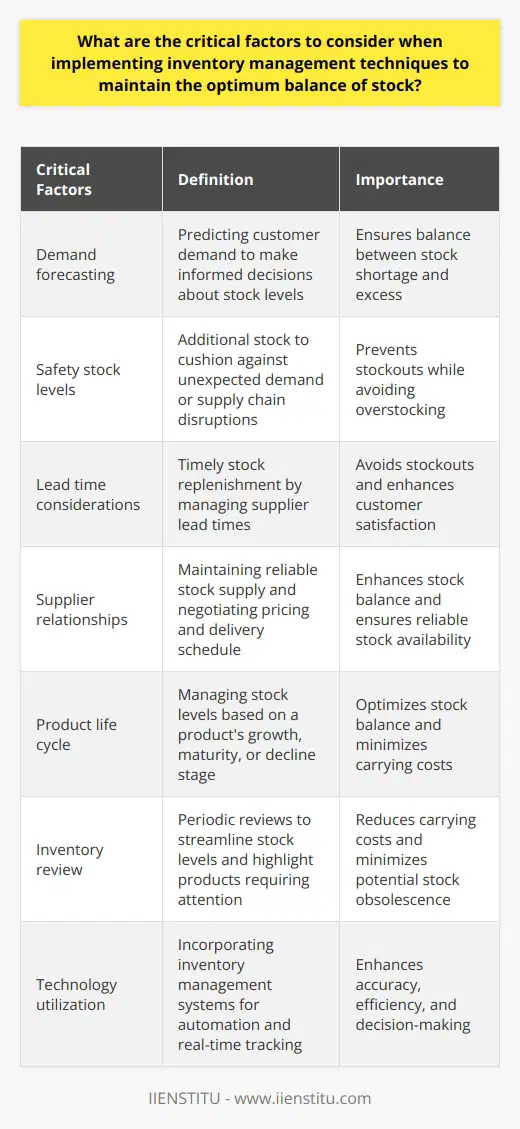
How does the integration of technology, such as warehouse management systems and automated inventory tracking, contribute to achieving efficient inventory control?
Role of Technology in Inventory Control
The assimilation of technology, exemplified by warehouse management systems (WMS) and automated inventory tracking, bolsters efficient inventory control. These technologies aid in enhancing precision, accelerating processes, and reducing possible human error.
Enhanced Precision
Employing automated systems brings remarkable precision in inventory control. Such systems accurately compute exact stock levels. Hence, eliminating manual counting and associated potential inaccuracies.
Accelerated Processes
Automated programmes, such as warehouse management systems, are inherently equipped with real-time data tracking. This feature speeds up processes, such as reordering, that rely on timely stock level information. Resultantly, this prevents stock-out situations, ensuring a steady flow of goods.
Reduced Human Error
Automation effectively minimises the error margin linked with manual data entry. Digital automation tools are less prone to mistakes than manual operations. This reliability translates into better inventory control, thereby decreasing losses associated with incorrect stock counts and misplaced orders.
Increased Profitability
Ultimately, adoption of advanced technological tools plays a critical part in driving profitability. Efficient inventory control reduces the chance of redundant stock, minimises storage space usage, and prevents product obsolescence. These factors result in significant financial savings.
In conclusion, incorporating technology into inventory control processes like warehouse management systems and automated inventory tracking, offers comprehensive benefits. It not only boosts efficiency and reliability but also contributes directly to enhancing profitability. Thus, technology is unmistakably instrumental in achieving effective inventory control.
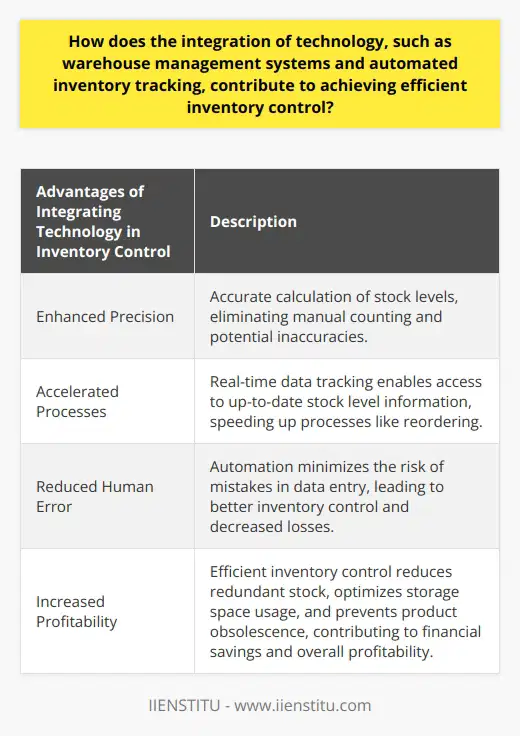
In what ways can organizations align their supply chain management practices with inventory control strategies to enhance overall operational efficiency and customer satisfaction?
Integrated Planning and Execution
Organizations can enhance operational efficiency by aligning supply chain management with inventory control strategies through integrated planning and execution. This approach ensures synchronization between supply and demand, reducing stock shortages and overages.
Just-In-Time Inventory Strategy
The Just-In-Time inventory strategy keeps inventory levels low, promoting responsive and efficient operations. By ordering only necessary items at the right time, organizations eliminate wastage and save on storage costs. This approach streamlines processes without sacrificing customer satisfaction.
Data Analytics
Data analytics also plays a key role in aligning supply chain management with inventory control strategies. Companies can use technology like predictive analytics to forecast demand accurately, avoid stockouts, and align orders with actual needs. This leads to an efficient inventory workflow that satisfies customer demands promptly.
Supplier Relationships
Managing supplier relationships properly ensures a consistent supply of goods, minimizing delays in order fulfillment. It facilitates communication, strengthens accountability, and supports timely delivery, contributing to customer satisfaction.
Cross-Functional Collaboration
Finally, organizations can foster cross-functional collaboration between sales, procurement, production, and delivery teams. Sharing information and coordinating operations improve both supply chain and inventory management efficiency. It reduces internal conflicts, promotes effective decision-making, and leads to improved customer service.
In conclusion, the alignment of supply chain management with inventory control strategies enhances operational efficiency and customer satisfaction. Integrated planning, Just-In-Time strategy, data analytics, supplier relationships, and cross-functional collaboration serve as effective tools for this alignment.
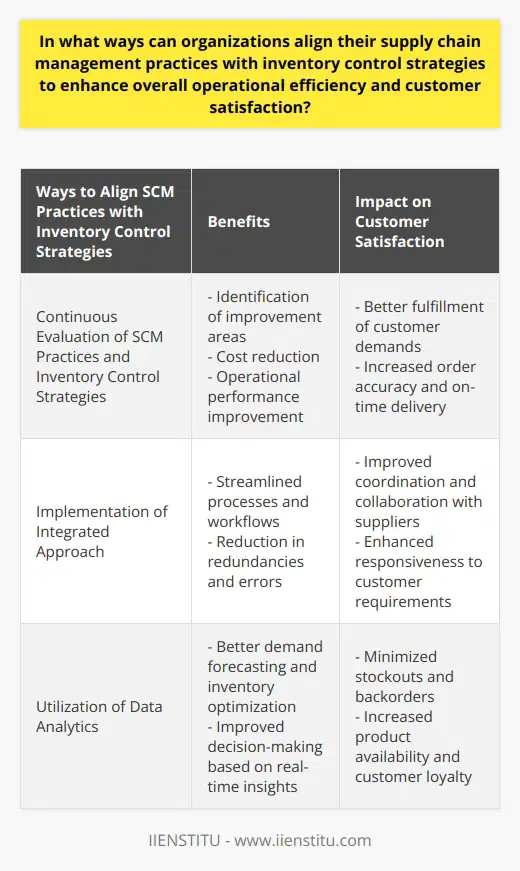
What are the three key aspects to successful inventory management?
Effective Forecasting
Firstly, successful inventory management requires effective forecasting. This involves predicting the demand for products with considerable accuracy. Accurate forecasting helps in maintaining optimal inventory levels, thus reducing storage costs.
Efficient Order Fulfillment
Secondly, efficient order fulfillment is a critical aspect of inventory management. This refers to the ability to satisfy customers' demands in a timely manner. By ensuring quicker delivery times, customer satisfaction increases, leading to favorable business outcomes.
Regular Stock Reviews
Lastly, conducting regular stock reviews is essential. Frequent inventory checking aids in identifying discrepancies, mismatches, or potential issues in stock levels. This proactive approach not only prevents stock-out or overstock scenarios but also improves overall inventory management.
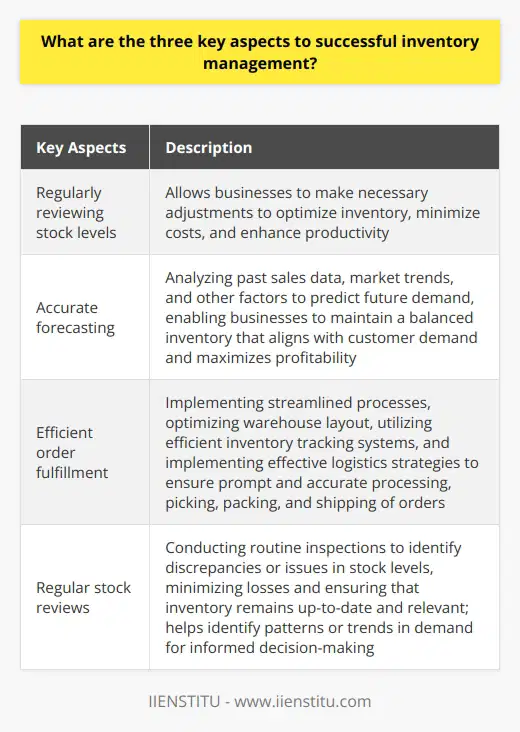
How can the ideal rule in managing inventory be best applied to ensure efficient stock levels and minimal costs?
Applying the Ideal Rule in Inventory Management
The ideal rule to ensure efficient stock levels and minimal costs in inventory management is Just-In-Time (JIT) strategy. Implemented effectively, this strategy can boost operational efficiency and reduce costs.
Just-In-Time Implementation
This strategy involves holding inventories at the least possible level to meet customer demands. Instead of piling up excess stock, JIT recommends ordering only what you need in the immediate future. The main benefit is cost savings from reduced storage space and lower investment in inventory.
Adopt Predictive Analytics
However, this approach requires accurate forecasting of future sales. Technological advancements have birthed tools such as predictive analytics, which can enhance the precision of demand forecasts. These tools crunch past and present data to predict future trends, hence facilitating more efficient JIT decision-making.
Reducing Stock Holding
A transport management system can help expedite the movement of goods from the supplier to the retailer. Faster deliveries mean shorter stock holding periods, which in turn result in lower carrying costs.
Mitigate Risks
Regardless of the benefits, a JIT strategy exposes firms to risks like supplier unreliability and sudden demand surges. To manage this, firms can diversify their supplier base, which will provide buffer stock to cushion against sudden demand hikes.
In essence, applying the JIT strategy, adopting predictive analytics, improving transportation, and diversifying suppliers forms the ideal rule in managing inventory. This process ensures efficient stock levels and minimal costs. Inventory management is a delicate science. Every firm should understand its unique circumstances and determine the optimal strategy for managing its inventories.
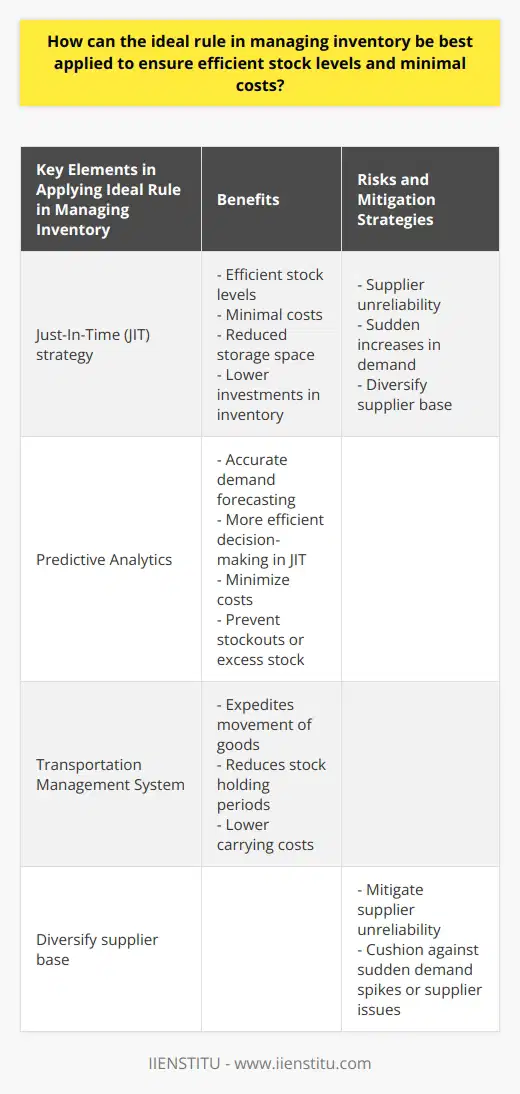
What role does data analysis and forecasting play in maintaining the optimum balance of inventory to meet customer demands while minimizing storage and carrying costs?
Demand Prediction
Data analysis and forecasting are indispensable in maintaining an optimum inventory. They serve a central role in predicting customer demands. Analyzing past sales data enables businesses to forecast upcoming trends, seasonal demands, and potential growth. This information accurately determines the quantity of stock required.
Inventory Optimization
Forecasting, backed by a robust data analysis, aids in making wise inventory decisions. It aligns inventory levels with the fluctuating demand, avoiding overstock or understock situations. This balance helps meet customer demands effectively without tying up too much capital in the inventory storage.
Storage Cost Minimization
Minimizing holding costs is a key advantage of efficient data analysis and forecasting. Accurate predictions mean a firm maintains only the necessary inventory levels. This strategy drastically reduces storage expenses. The company can invest the saved cost in other areas to promote business growth.
Ordering Cost Control
Meanwhile, data analysis helps in controlling ordering costs. The firm knows when to reorder and how much to order, minimizing the frequency of small, expensive orders. This practice contributes to the company's overall cost efficiency.
Survival in Competitive Market
In today's competitive market, the utility of data analysis and inventory forecasting lies beyond cost control. It facilitates a company's survival through improved customer service. Satisfied customers, resulting from prompt delivery and no stock-outs, foster customer loyalty and enhance brand image.
In conclusion, data analysis and forecasting play a pivotal role in achieving balance in inventory management. They help meet customer demands while minimizing associated costs, creating competitive advantages, and supporting the long-term success of a business.
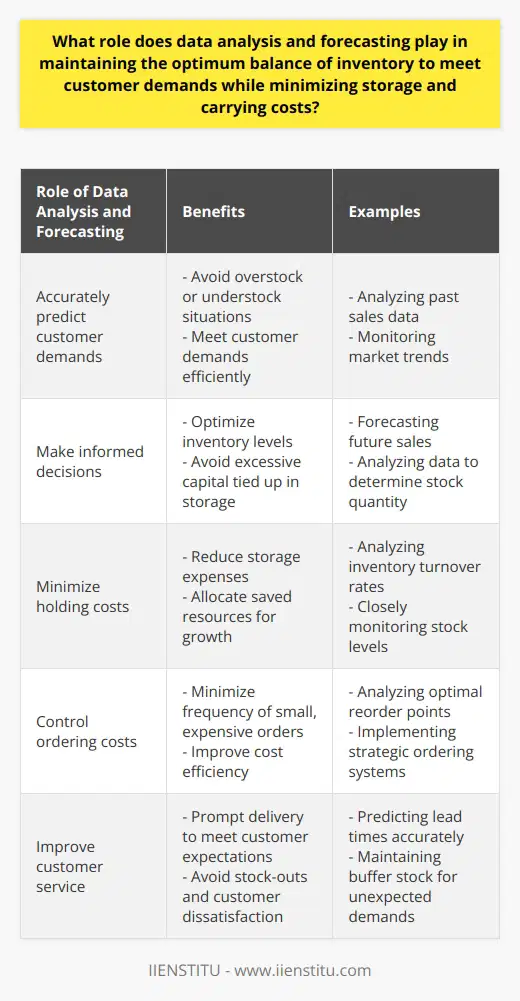
Why is it difficult for managers to get the proper balance of inventory?
Inventory Control Challenges
Managers often struggle to maintain the right inventory balance. Numerous factors account for this difficulty.
Demand Forecasting
The first is predicting consumer demand. Precise forecasting is complex due to sporadic buying patterns and trends. Overestimation leads to excess inventory while underestimation results in stockouts.
Supplier Reliability
Secondly, the reliability of suppliers plays a critical part. A shortage of supplies or delivery delays affects inventory levels and sales. During these periods, maintaining adequate stock levels becomes tricky.
Changing Market Trends
Thirdly, rapid changes in the market make it difficult to maintain appropriate inventory levels. Trends, tastes, and preferences change quickly, making certain items obsolete. Inventory may lose value or even become unsellable, adding to a company's losses.
Storage and Handling Costs
Lastly, the costs of storage and handling can complicate the balance. Excessive stock contributes to high warehouse costs. On the other hand, low stock levels decrease these costs but increase the risk of lost sales.
Inventory Management Techniques
For effective inventory management, managers should master the art of balancing these factors. Proper inventory forecasting and supply chain management are essential. Regular reviews and adjustments to inventory levels in response to changing market trends and conditions can aid in this. Despite the challenges, efficient inventory management remains a critical element in successful business operations.
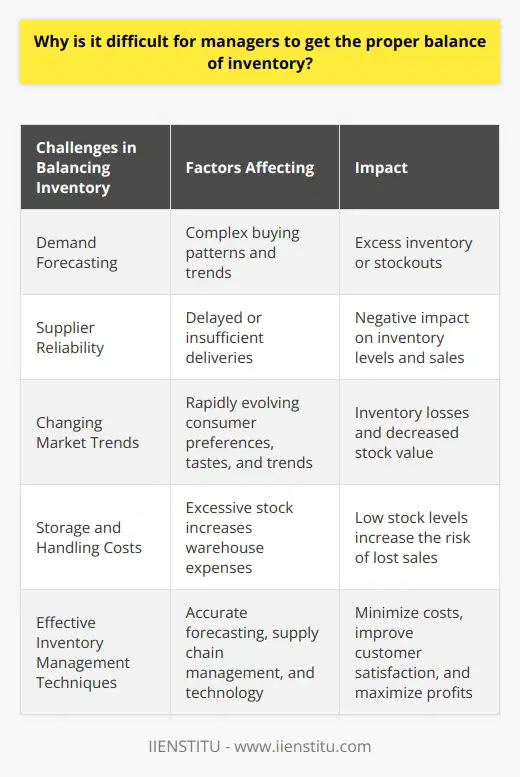
What role does demand forecasting play in maintaining the optimum balance of inventory, and how can organizations improve their predictions for more accurate stock control?
Role of Demand Forecasting in Inventory Balance
Demand forecasting holds a critical role in maintaining an ideal inventory balance. It offers an estimate of the goods and services that customers may purchase in the forthcoming period. Without accurate demand forecasting, organizations risk either a surplus or a deficit of stock, leading to financial losses or customer dissatisfaction.
Improving Predictions for Accurate Stock Control
Firstly, organizations can use historical sales data to project future demand. Past trends frequently provide insights into future behavior. Secondly, using advanced forecasting techniques can add accuracy. Methods such as time series analysis and causal models can make forecast more reliable.
Role of Technology and Expertise
The use of modern technology can help with better and faster analysis. Tools that use artificial intelligence and machine learning can derive patterns from complex data sets. However, effective use of these tools requires both technological and industry expertise.
Incorporating Market Variables
Demand doesn't depend solely on past patterns. Market variables such as competition, economic conditions, and consumer behavior changes also influences it. Therefore, integrating these variables into the forecasting model is necessary for a well-rounded approach.
The Importance of Regular Review
Finally, organizations must update their forecasts regularly. Changes in market conditions or internal changes at a company may require revisions in forecasts. Constant review ensures that these predictions remain relevant, improving stock control accuracy.
In conclusion, demand forecasting plays a crucial role in stock control. Enhancing predictability through a combination of tools, techniques, and regular review can enable organizations to achieve optimal inventory balance. Doing so reduces waste, prevents stockouts, and enables a more efficient use of resources.
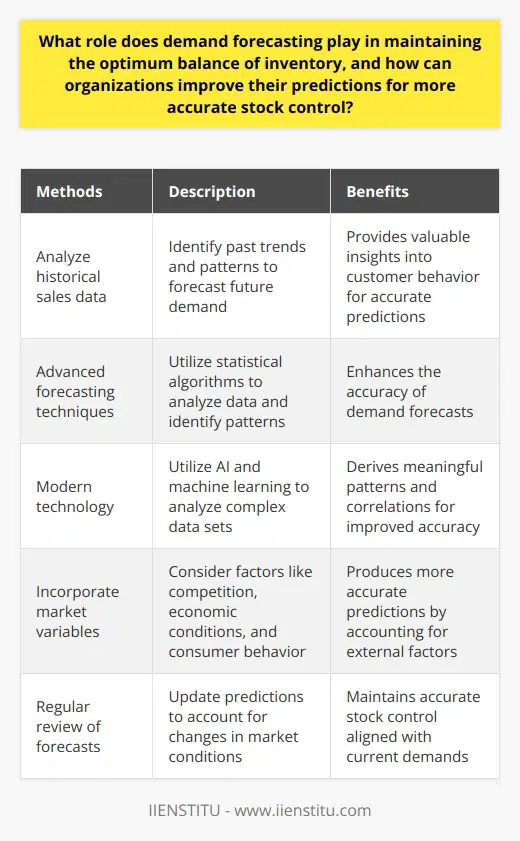
How can companies proactively identify inventory management challenges and implement solutions to mitigate risks and optimize stock levels?
Leverage Predictive Analytics:
Implementing predictive analytics can enable companies to identify inventory management challenges proactively. Using historical data and advanced algorithms, predictive analytics can forecast future demand and associated inventory needs.
Adopt Real-Time Monitoring:
Real-time monitoring of inventory provides precise insights into stock levels. This real-time access to information ensures timely decision-making, which can lead to more prompt and effective solutions to arising challenges.
Integrate Supplier Relationship Management:
By fostering solid relationships with suppliers, companies can better negotiate terms and conditions. This strategy can help ensure consistent availability of goods, thereby minimizing the risk of stock shortage and overstock.
Invest in Automation:
Automation of inventory management processes can substantially reduce errors. Automated systems can track stock levels more accurately, thereby preventing issues like stockouts and overstocking.
Promote Cross-Functional Collaborations:
Companies must encourage collaboration between different departments such as sales, purchasing, and warehousing. Cooperation across departments can result in a holistic view of inventory management, facilitating more coordinated efforts in managing stock levels.
Upskill Personnel:
Equipping personnel with appropriate skills and knowledge in inventory management can go a long way in identifying potential challenges. Training sessions can equip staff with the capacity to handle associated risks and ensure optimal stock management.
Enhance Reporting and Performance Metrics:
Efficient reporting can provide an accurate picture of stock movement, alerting companies to potential concerns. Key performance metrics, like inventory turnover rate and gross margin return on investment, can assist in evaluating the effectiveness of inventory management strategies.
In conclusion, identifying inventory management challenges proactively necessitates the adoption of modern tools and strategic practices. By investing in predictive analytics, real-time monitoring, supplier relationship management, automation, cross-functional collaborations, personnel upskilling, and enhanced reporting, companies can mitigate risks and optimize their stock levels.
